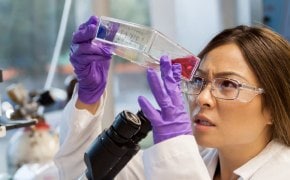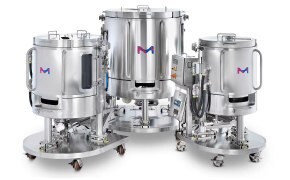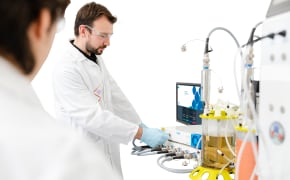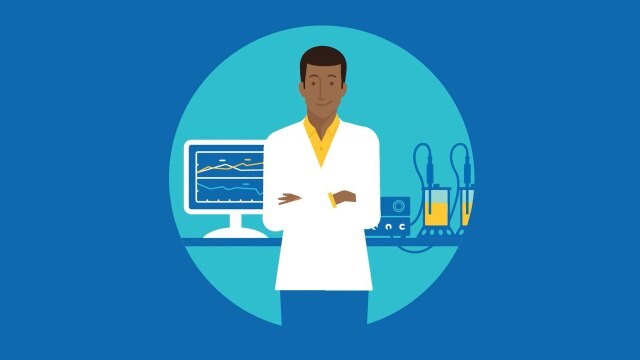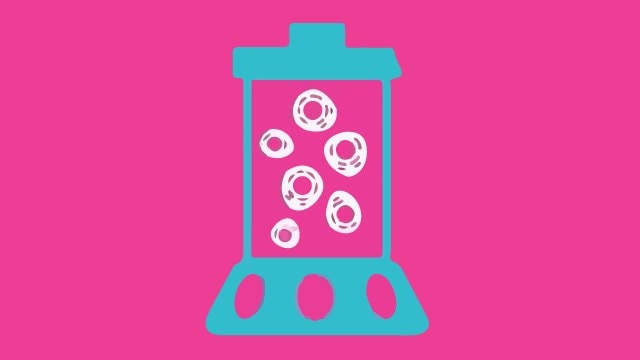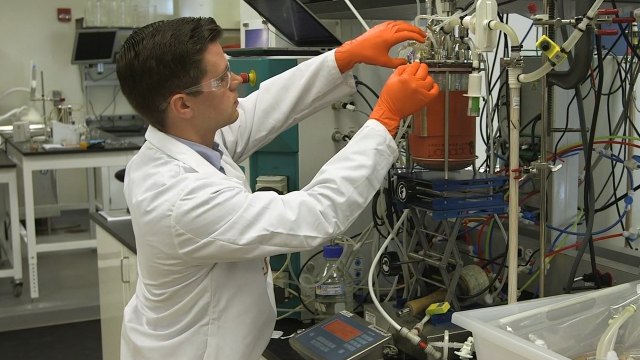mAbs Upstream
Produkty do rozwoju i produkcji.
Przebieg pracy obejmuje wszystkie etapy prowadzące do zbioru komórek, w tym optymalizację warunków hodowli, rozwój linii komórkowej.linia komórkowa i charakteryzacja produktu, rozwój mediów, chemikalia procesowe; oraz skalowanie procesu wsadowego, wsadowego z podawaniem lub perfuzji do większych bioreaktorów. Celem wyższego szczebla biomanufacturingu jest zwiększenie gęstości komórek i miana produktu.
Przetwarzanie na wyższym poziomie
Optymalizacja i intensyfikacja przetwarzania biologicznego na wyższym poziomie
Zoptymalizowany proces upstream stanowi podstawę udanej produkcji przeciwciał monoklonalnych (mAb) w fazie klinicznej i komercyjnej. Istnieje wiele możliwości zwiększenia wydajności, intensyfikacji, kontroli, analizować i digitalizować przetwarzanie danych, wraz z wieloma wyzwaniami. Konieczne jest opracowanie wysokowydajnych linii komórkowych oraz optymalizacja pożywek i pasz do hodowli komórkowych. Monitorowanie w czasie rzeczywistym krytycznych parametrów procesu (CPP), a także zautomatyzowane aseptyczne pobieranie próbek jako zaawansowane narzędzia PAT są wysoce zalecane w celu lepszego zrozumienia procesu i jakości produktu. Ponadto, warunki wzrostu ustalone podczas opracowywania procesu muszą być odpowiednie dla produkcji na pełną skalę.
Powiązane kategorie
Linia komórkowa, która utrzymuje korzystny wzrost i produktywność jest niezbędna do produkcji mabów.
Nasze pożywki do hodowli komórkowych sprawiają, że zintensyfikowane lub zasilane procesy wsadowe są bardziej niezawodne i wydajne.
Nasze rekombinowane suplementy pochodzenia niezwierzęcego (NAO) są przeznaczone do hodowli komórkowych.
Rozwiązania do mieszania jednorazowego użytku firmy Mobius® obejmują pełną gamę mieszalników o pojemności od 10 l do 3 000 l.
Rodzina bioreaktorów Mobius® obsługuje procesy wsadowe, wsadowe z podawaniem i perfuzyjne.
Nasza szeroka oferta filtrów membranowych oferuje opcje wydajnego przetwarzania każdego strumienia farmaceutycznego i biofarmaceutycznego.
Powiązane zasoby
- Optimizing Upstream Media and Feeds in Bioprocessing
Developing a robust upstream cell culture process that maximizes productivity without increasing complexity relies on the right combination of bioprocess medium and feed and the ability to maintain tight control of culture conditions. Learn more how to achieve this.
- Seed Train Intensification Using High Cell Density Cryopreservation
This article explains the benefits of high cell density cryopreservation (HCDC) and how to implement it.
- Cell Retention Technology and Specialized Cell Culture Media for Intensified Upstream Processing
This study demonstrates the use of a Cellicon® filter and controller in an N-1 perfusion process with Cellvento® 4CHO-X expansion medium as compared to a control seed train using shake flasks.
- Seamless Integration of Glucose Control in CHO Culture Using Raman Spectroscopy
In this study, a ProCellics™ Raman Analyzer with Bio4C® PAT Raman Software (Raman PAT Platform) was used to implement a feedback control loop in a CHO cell culture process to monitor glucose concentration and enable maintenance of stable glucose levels without the need for manual intervention.
- In-Line Real-Time Monitoring of CHO Cell Culture Process Parameters using Raman Spectroscopy
This article explains how ProCellics™ Raman Analyzer with Bio4C® PAT Raman Software (the Raman PAT Platform) can be used to perform in-line and real-time measurement of TCD, VCD and mAb titer as well as the concentration of glucose, lactate, and ammonium in a bench-scale bioreactor, and how it compares with off line monitoring.
- Operational and Financial Advantages of Cellicon® Cell Retention Solution in an N-1 Perfusion Process
The following study compares an N-1 perfusion process at the 2,000 L scale using our Cellicon® Cell Retention Solution versus a commercially available cell retention device.
- Reproducible Scaling of a Cell Retention Filter Using the Cellicon® Cell Retention Solution
This page describes the design attributes of the Cellicon® Filter Assembly and how they simplify process scale-up.
- Improving Fed-Batch Yields in Upstream Bioprocessing
In this article, we’ll walk through media and feed screening strategies suitable for many cell lines and manufacturing scenarios using our EX-CELL® Advanced and Cellvento® Fed-batch platforms.
- Upstream Bioprocessing Feed Strategies and Scalability
Prior to scaling your upstream bioprocess to bioreactors, it’s best to set up small-scale cultures to determine the media and feed combinations. In this case study, we demonstrate this process using our Cellvento® ModiFeed Prime COMP feed.
- One-step Feed Optimization for Upstream Cell Culture Processes
Optimizing media and feed formulations is essential for efficient and cost-effective upstream workflows. Here we’ll discuss a one-step feed optimization using EX-CELL® Advanced CHO Feed 1 and Cellvento® 4Feed to improve monoclonal antibody (mAb) producing clones.
- Chemically Defined Media Supplements Improve Quality and Lower Risk in Upstream Bioprocessing
As a case study, we’ll take a look at how we created the chemically defined supplement EX-CELL® CD Hydrolysate Fusion and its performance in mAb-producing CHO cell lines.
- Impact of DMSO And Freezing Technique in Developing a High Cell Density Cryopreservation Process for Upstream Bioprocessing
Here, we evaluated how dimethyl sulfoxide and freezing techniques impact viable cell density and titer production in an HCDC intensified seed train.
- Preparing CHO Cells for Higher Productivity by Optimizing a Perfused Seed Train
This application note describes the benefits and performance of Cellvento® 4CHO-X Expansion Medium designed for multiple cell expansion steps from vial thaw to N-1 stages to generate higher biomass for inoculating fed-batch production bioreactors.
Zapoznaj się z naszymi rozwiązaniami
Zaloguj się lub utwórz konto, aby kontynuować.
Nie masz konta użytkownika?

